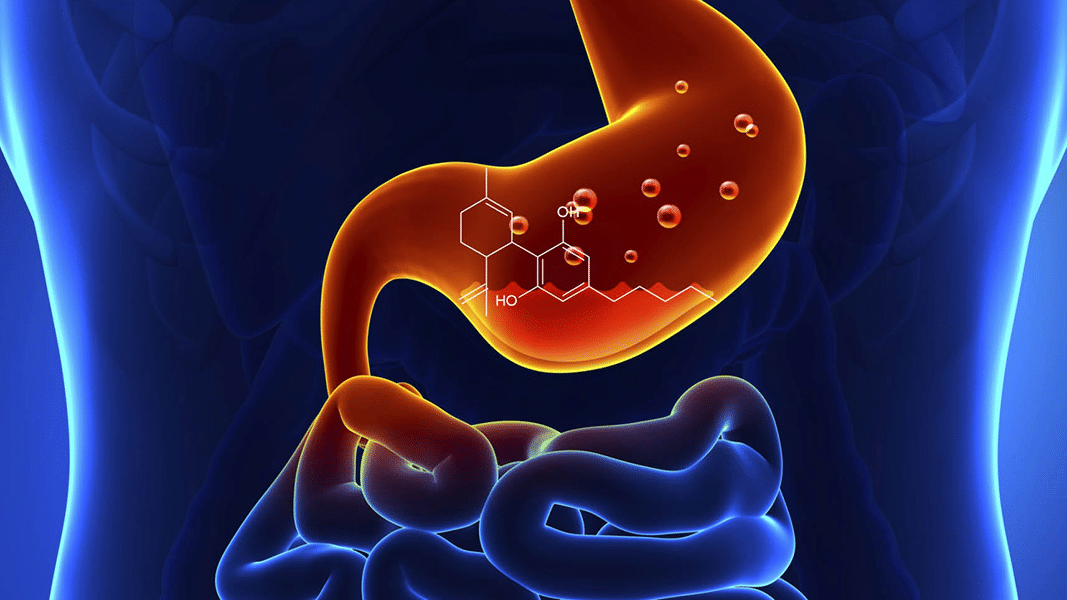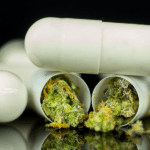In 2016, a new journal Cannabis and Cannabinoid Research published a paper suggesting that non-psychoactive cannabidiol (CBD) converts to psychoactive tetrahydrocannabinol (THC) in the stomach. The controversial paper was coauthored by several scientists employed by Zynerba Pharmaceuticals in Devin, Pennsylvania. It was not the first time that researchers addressed this issue.
In considering whether CBD converts to THC in the stomach, there are three major kinds of data that scientists examine:
- The first involves blood samples and physiological tests of humans who have ingested CBD, which demonstrates if they are actually exposed to THC and if they experience THC-like effects after CBD administration.
- The second kind of data involves studies that examine excreted metabolites after ingestion of CBD. Excretion studies may not prove that a particular metabolite is physiologically relevant, but they could prove if these breakdown metabolites are formed.
- And the third and least significant type of data derives from experimental organ models—such as artificial gastric fluid or extracted liver microsomes—that might demonstrate the possibility of a CBD-to-THC conversion, but does not necessarily translate into human experience.
The recent article by John Merrick et. al. (2016) that sparked renewed interest in CBD’s potential conversion to THC falls into the third category. It raised concerns among patients, physicians and policymakers about possible adverse side effects that might limit CBD’s otherwise formidable therapeutic utility and market potential. Misinformation regarding the consequences of oral CBD administration could skew public policy and regulatory decisions at a time when cannabinoid therapies are gaining favor among health professionals and the general public.
Inconsistent Findings
There have been extensive clinical trials demonstrating that ingested CBD—even doses above 600 mg—does not cause THC-like effects.1 The lack of THC-like effects was discussed in detail by Grotenhermen et. al. (2017) in a response to Merrick’s publication. The lack of such effects strongly suggests that CBD does not trigger significant CB1 receptor activity in the brain, which would cause a THC-like “high.” One clinical study examined the blood concentration of THC and its active metabolites after 16 men ingested 600 mg of CBD; the resulting change in the concentration of THC metabolites was statistically meaningless. To the extent that THC is formed from orally ingested CBD, it is physiologically insignificant.
There are a few human studies indicating that very small amounts of THC are excreted in urine after someone ingests CBD. Less than 1% of the total CBD is excreted as ∆9-THC, and between 1-2% is excreted as ∆8-THC. These studies demonstrate that a small amount of ingested CBD does isomerize to THC, but this in and of itself has no practical significance. The clinical evidence demonstrating that CBD does not cause THC-like effects subsumes any imagined physiological consequences associated with this data.
Two studies have explored the conversion of CBD to THC in artificial gastric fluid: One performed by Watanabe et. al. (2007) and the recent publication by Merrick and colleagues. Although Merrick cites Watanabe’s work to build the case for CBD-to-THC conversion in the stomach, Merrick’s experiment is strikingly inconsistent with Watanabe’s data. In Watanabe’s simulated gastric fluid study, 15.4% of the CBD was converted into four compounds: ∆9-THC, CBN, 8-OH-iso-HHC, and 9a-OH–HHC. (The major product, 8-OH-iso-HHC, is approximately 15 times less potent than THC). Less than 3% of the CBD was actually converted to THC in this experiment, which lasted 20 hours—much longer than CBD remains in the stomach. Yet the article by Merrick proposed that 85% of CBD will break down in a single hour. In other words, the reaction that occurred in Merrick’s study was over 200 times faster than the reaction in Watanabe’s study.2 This discrepancy may be due to different stomach fluid models, and it raises questions about the validity of both models. Moreover, it should be noted that Watanabe explicitly states: “In biological systems, there have been no reports on the conversion of CBD to ∆9-THC itself.”
In Merrick et. al. the discussion following the presentation of test data far outpaces the minor implications of their work. They propose an equation to estimate “THC exposure” after CBD ingestion. What does this equation do for the reader? It provides the reader with information that is at best wildly speculative, and at worst totally wrong. But what does it do for the authors? It inflates the minimal significance of their simulated gastric fluid experiment and conveys a misleading impression that they have discovered something truly important about the use of oral cannabinoid medicine.
From Bad to Worse
The weakest aspect of Merrick’s research is found in the authors’ response (Bonn-Miller et. al. 2017) to cogent criticism about their methodology and conclusion. Published in the same journal, Bonn-Miller’s response is replete with subtle distortions and demonstrable falsehoods, including misrepresentation of the studies they reference to back up their initial report.
In one particularly egregious example, the authors state that “studies documented… poor motor and cognitive performance after administration of oral CBD,” citing an article by Consroe (1979). The actual study by Consroe states that “alcohol and alcohol + CBD, but not CBD given singly, produce decrements of motor and cognitive responses [emphasis added].”
In an attempt to discredit one of the two human studies demonstrating that ingested CBD does not convert to THC to a significant degree, Merrick and his coauthors assert that a chart included in a paper by Martín-Santos et. al. (2012) shows an increase in THC metabolites after CBD administration. But the trend shown in the chart is not only statistically insignificant, it is so minuscule as to be clinically irrelevant.
Other claims in the article, while not outright falsehoods, misrepresent the work of other authors. The conversion of CBD to THC, previously documented by Gaoni and Mechoulam (1968), did not occur in simulated gastric conditions, but rather was performed in a highly unnatural setting with CBD dissolved in sulfuric acid and methanol. This reaction is entirely valid in the realm of chemical synthesis, but it has little to do with real-life human experience.
Merrick and his cohorts also suggest that a recent review by István Ujváry and Lumir Hanuš (2016) “highlighted” the “consistent findings of CBD conversion to THC.” But only a single sentence in this review mentions the conversion of CBD to THC, and this sentence was accompanied by a figure caption indicating that ∆9-THC was a “minor (<1%) urinary metabolite.” Ujváry and Hanuš also note the presence of a small amount of ∆8-THC, which is less psychoactive than ∆9-THC.
It is unclear if the journal Cannabis and Cannabinoid Research peer-reviewed the response to criticism of Merrick’s article, as the response does not appear to meet the standards of scientific reporting. The purpose of peer-review is for scientists to confirm the validity of a paper before publication so that others can read it without questioning the accuracy of its contents. In publishing this response by Bonn-Miller et. al., Cannabis and Cannabinoid Research seems to have failed that goal.3
But the authors may have succeeded in advancing the agenda of Zynerba Pharmaceuticals, the company that funded their research. Zynerba disclosed in a press release (April 12, 2016) that it was developing a transdermal delivery system that “avoids the gastrointestinal tract and potential stomach acid degradation of CBD into THC (associated with psychoactive effects).” In other words, Zynerba has a financial interest in depicting oral CBD, which is well tolerated in clinical research, as potentially harmful.
While purporting to solve a problem that doesn’t actually exist may not amount to much scientifically, Zynerba isn’t the only company making erroneous claims about CBD converting to THC in the stomach. Ananda Scientific, a privately-held Delaware corporation, tried to one-up its competitors by asserting that its hemp-derived CBD formulation is “protected from being transformed, after it is ingested, into THC which is a risk factor in other existing [hemp CBD] products.”
Adrian Devitt-Lee is a research scientist and longtime Project CBD contributor. © Copyright, Project CBD. May not be reprinted without permission.
Footnotes
- There are, of course, many effects common to both THC and CBD. The “tetrad” test that is used to assay CB1 receptor activity involves measuring catalepsy, hypothermia, hypomotility, and analgesia. Ingested CBD consistently evokes analgesia, but is inactive on other measures of the tetrad.
- The rate constant from Merrick’s study was -3.1 * 10^-2 per min, while it was -1.4 * 10^-4 per min in Watanabe’s study. The rate constant for Watanabe’s experiment can be calculated as follows. If we assume first-order kinetics – which makes sense for the degradation of a molecule – then [CBD] / [initial CBD] = exp(-k * t), where k is the rate constant, and […] indicates we are considering concentrations. Since 15.4% of the CBD had degraded at 20 hours (1200 min), the left side of the equation is 1-0.154 = 0.846 when ‘t’ on the right side is 1200 min. Solving for k, we see that k = -ln(0.846)/1200 min ≈ -1.4 * 10^-4/min. If we then compare these rate constants, we see that k_Merrick/k_Watanabe = 222, meaning that CBD degraded 222 times faster in Merrick’s experiment than in Watanabe’s.
- A coauthor of Grotenhermen’s article told Project CBD that their critical commentary was peer-reviewed before publication. But when asked by Project CBD, the editor of Cannabis and Cannabinoid Research did not comment on whether or not Bonn-Miller (2017) was peer-reviewed. Dr. Bonn-Miller, who was the first author of the response to criticism but was not an author on Merrick’s initial publication, is on the editorial board of Cannabis and Cannabinoid Research.
Sources
- Bergamaschi MM, Queiroz RHC, Zuardi AW, Crippa JAS. Safety and Side Effects of Cannabidiol, a Cannabis sativa Constituent. Current Drug Safety. 2011, 6:237-249.
- Bonn-Miller M, Banks SL, Sebree T. Conversion of Cannabidiol Following Oral Administration: Authors’ Response to Grotenhermen et al. Cannabis and Cannabinoid Research. January 2017, 2(1): 5-7.
- Consroe P, Carlini EA, Zwicker AP, Lacerda LA. Interaction of Cannabidiol and Alcohol in Humans. Psychopharmacology. 1979, 66:45-50.
- Gaoni Y and Mechoulam R. The iso-tetrahydrocannabinols. Israeli Journal of Chemistry. 1968, 6:679-690.
- Grotenhermen F, Russo E, Zuardi AW. Even High Doses of Oral Cannabidiol do not Cause THC-like Effects in Humans: Comment on Merrick et al. Cannabis and Cannabinoid Research. January 2017, 2(1): 1-4.
- Martín-Santos R, Crippa JA, Batalla A, Bhattacharyya S, Atakan Z, Borgwardt S, Allen P, Seal M, Langohr K, Farré M, Zuardi AW, McGuire PK. Acute Effects of a Single, Oral Dose of d9-tetrahydrocannabinol (THC) and Cannabidiol (CBD) Administration in Healthy Volunteers. Current Pharmaceutical Design. 2012, 18:4966-4979.
- Merrick J, Lane B, Sebree T, Yaksh T, O’Neill C, and Banks SL. Identification of Psychoactive Degradants of Cannabidiol in Simulated Gastric and Physiological Fluid. Cannabis and Cannabinoid Research. April 2016, 1(1): 102-112.
- Ujváry I and Hanuš L. Human Metabolites of Cannabidiol: A Review on Their Formation, Biological Activity, and Relevance in Therapy. Cannabis and Cannabinoid Research. March 2016, 1(1): 90-101.
- Watanabe K, Itokawa Y, Yamaori S, Funahashi T, Kimura T, Kaji T, Usami N, Yamamoto I. Conversion of cannabidiol to ∆9-tetrahydrocannabinol and related cannabinoids in artificial gastric juice, and their pharmacological effects in mice. Forensic Toxicology. 2007 25:16-21.
See also:
- Solomon, Shoshanna, “Israeli cannabis-based nanotech droplets start US sales,” The Times of Israel, Dec. 5, 2016.
- Zynerba Pharmaceuticals, Inc., “Cannabis and Cannabinoid Research Publishes Data Demonstrating the Degradation of Cannabidiol to Psychoactive Cannabinoids when Exposed to Simulated Gastric Fluid,” press release, April 12, 2016.







